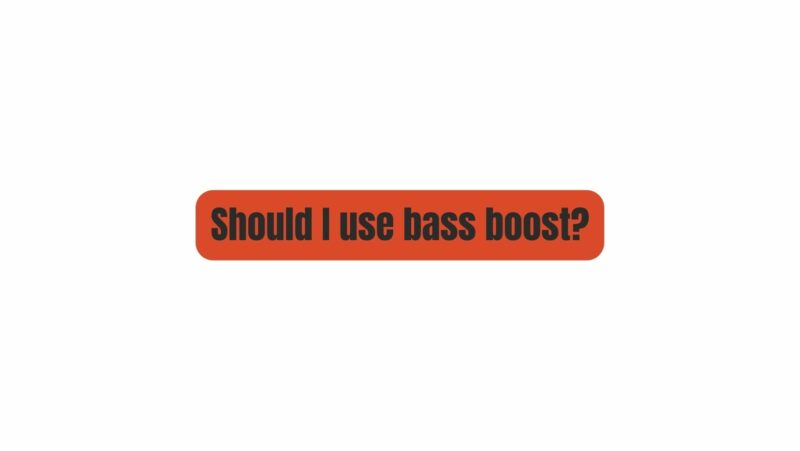Music has the unique ability to stir emotions, and for many, the deep, rhythmic pulse of bass plays a pivotal role in creating a truly immersive experience. To cater to this craving for bass, many audio systems come equipped with a feature known as “bass boost.” This function promises to elevate the bass frequencies, making them more pronounced and powerful. But should you use bass boost in your audio setup? In this article, we’ll embark on a sonic journey to explore the merits and potential drawbacks of using bass boost and help you decide whether it’s a feature that enhances or detracts from your listening pleasure.
Demystifying Bass Boost
Before we delve into the debate surrounding bass boost, let’s begin by unraveling what this feature entails. At its core, bass boost is an equalization (EQ) feature designed to augment low-frequency sound reproduction in your audio signal. In simpler terms, it’s a tool that amplifies the bass frequencies, aiming to create a more prominent and visceral bass response.
The Temptation of Deep Bass
The appeal of bass boost is undeniable. A robust and resonant bassline can add depth and dimension to your music, evoking emotional responses and enhancing the overall listening experience. The allure of bass boost includes:
- Enhanced Musicality: Bass boost has the potential to breathe new life into your music. By accentuating the low-end frequencies, it can make your tunes feel more vibrant and emotionally engaging.
- Genre Adaptability: Some music genres, such as hip-hop, electronic dance music (EDM), and reggae, rely heavily on powerful basslines. In these cases, bass boost can elevate your listening experience to new heights, delivering the intended impact of the music.
- Personal Preference: Ultimately, the decision to engage bass boost is subjective. If you find that it enhances your enjoyment of music and aligns with your taste, then there’s nothing wrong with using it in moderation.
The Caveats of Bass Boost
While the appeal of enhanced bass is evident, the use of bass boost is not without potential pitfalls. It’s essential to be aware of the following concerns:
- Distortion Risk: One of the primary risks associated with excessive bass boost is distortion. When you push the bass levels too far, it can overwhelm your speakers and amplifiers, leading to audible distortion. Not only does this compromise audio quality, but it can also potentially harm your equipment over time.
- Frequency Imbalance: Bass boost is not a precision tool. It tends to emphasize a specific range of frequencies, which can result in an unbalanced sound profile. While the bass might be booming, other frequency ranges, such as midrange and treble, may be overshadowed, leading to an uneven and less enjoyable listening experience.
- Speaker and Subwoofer Compatibility: The effectiveness of bass boost largely depends on the quality and capacity of your speakers and subwoofers. If your audio components are not up to the task, they may produce muddy or distorted sound. This underscores the importance of matching your equipment to achieve optimal performance.
- Listening Environment Matters: The impact of bass boost can vary depending on your listening environment. What sounds fantastic in one setting may not be suitable for another. For example, using bass boost in a small, confined space like a car interior can lead to excessive bass resonance, creating a less enjoyable listening experience.
When to Consider Bass Boost
Despite the potential drawbacks, there are scenarios where using bass boost can be a valid choice:
- Music Genre Preference: If you primarily listen to genres that heavily feature bass, such as EDM, hip-hop, or dubstep, a modest amount of bass boost can intensify your listening experience. However, moderation is crucial to avoid distortion.
- High-Quality Audio Components: Premium speakers, subwoofers, and amplifiers are better equipped to handle increased bass levels without distortion. If you have top-tier audio components, you can enjoy bass boost without sacrificing audio quality.
- Listening Environment Optimization: In some situations, like a car’s confined acoustic space, a subtle bass boost can help compensate for the natural loss of low frequencies due to the cabin’s size and shape. Finding the right balance may require experimentation.
- Personal Audio Preference: Ultimately, the decision to use bass boost should align with your personal taste in music and sound. If you enjoy that extra punch of bass and it enhances your enjoyment of your favorite tracks, then it’s a valid addition to your audio setup.
Striving for Audio Balance
Perhaps the most critical consideration when contemplating the use of bass boost is balance. Balance is the key to a satisfying listening experience. Instead of cranking up the bass boost to the maximum, aim for a subtle and controlled enhancement that complements your music rather than overpowering it.
Moreover, trust your ears as your ultimate guide. Listen attentively to your audio system with and without bass boost engaged. Make adjustments until you find a setting that preserves the overall balance of the music while adding the desired low-end depth.
Conclusion: A Tool, Not a Panacea
In the world of audio, bass boost is a tool that, when used judiciously, can enhance your listening pleasure. However, it’s crucial to approach it with care and an understanding of its potential pitfalls. Bass boost should complement your audio experience, not dominate it. By thoughtfully balancing your audio settings and considering factors such as music genre, speaker quality, listening environment, and personal preference, you can harness the power of bass boost to create an audio system that resonates with your musical tastes. Remember, it’s all about finding the sweet spot where the bass enhances your enjoyment without overshadowing the rest of the music.


